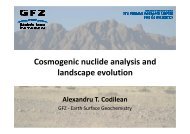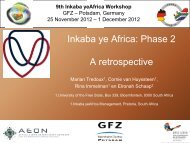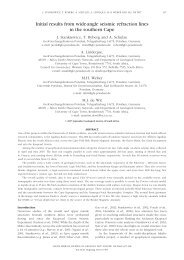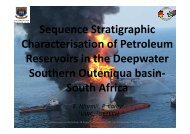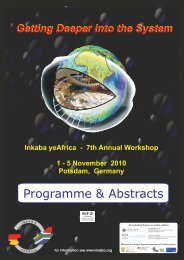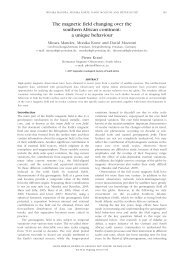South Africa - Inkaba.org
South Africa - Inkaba.org
South Africa - Inkaba.org
Create successful ePaper yourself
Turn your PDF publications into a flip-book with our unique Google optimized e-Paper software.
Carbonate alteration of dolerite intruding coal seams: Natural<br />
carbon sequestration during fossil fuel combustion?<br />
Reginald T Mathivha 1 , J. Vogeli 2,3 , D. Reid 4<br />
1. Department of Geological Sciences, University of Cape Town, <strong>South</strong> <strong>Africa</strong>, mthreg003@uct.ac.za<br />
2. Centre for Minerals Research, Department of Chemical Engineering, University of Cape Town,<br />
vgljac001@uct.ac.za<br />
3. Department of Geological Sciences, University of Cape Town, <strong>South</strong> <strong>Africa</strong>, vgljac001@uct.ac.za<br />
4. Department of Geological Sciences, University of Cape Town, <strong>South</strong> <strong>Africa</strong>, david.reid@uct.ac.za<br />
ABSTRACT<br />
Recent investigations of Karoo dolerite intrusions into coal seams have revealed the operation of what seems to be<br />
a natural carbon sequestration process perhaps significant in our understanding of industrial methods designed to<br />
curb the buildup of greenhouse gases in the atmosphere.<br />
Significant carbonation of the dolerite intrusions in the vicinity of coal points to redox reactions driven by<br />
magmatic temperatures, abundant fluids and geological time scales. A principal aim of the current study is<br />
determine whether the carbonates are derived from reactions involving olivine, pyroxenes and feldspars that<br />
constitute the original magmatic assemblage. An insight to these reactions could aid in devising possible industrial<br />
processes that could be applied.<br />
Acid leaching and gasimetry analysis have been done in order to determine the amount of CO2 in the samples.<br />
Optical microscopy, QEMSCAN, XRD and EMP techniques has been used to determine the textural relations,<br />
carbonate - silicate interactions, mineral structure and compositional patterns.<br />
While it is clear that Karoo dolerite has the potential to absorb significant carbon dioxide (25-35%) given the right<br />
circumstances and environment, alternative but mineralogically similar reservoir materials are abundantly available<br />
in the form of mine tailings.<br />
KEYWORDS: Dolerite Dyke, carbon sequestration<br />
51



